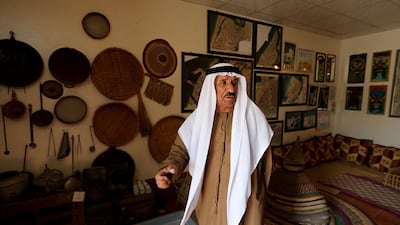RAS AL KHAIMAH // As it develops its standing as a major player in the UAE’s tourism industry, the northernmost emirate is working to put some of its less well-known cultural and historical gems in the spotlight, including museums, 60 well-preserved forts and a “ghost town”.
Naser Bin Hassan Alkas has seen the emirate change dramatically over his nearly 90 years. The Emirati has collected hundreds of pieces to represent RAK’s history, some dating to the 1600s and the days of the Portuguese and Dutch occupations, in his collection at the Bin Majid Museum, also known as the RAK National Museum, open since 1984.
“I wanted to focus on maintaining the history and culture. I’ve been asking the authorities to make the museum more visible and accessible,” he said.
“We have a lot of school visits but not many tourists. We need to encourage people to come here and learn about the local culture.”
Entry to the museum is free and is funded by donations from Sheikh Saud bin Saqr Al Qasimi, Ruler of Ras Al Khaimah, and the Ministry of Culture.
“We would love to expand. We don’t have enough space for all the pieces we have here in storage,” said Mr Alkas.
“We have offered local hotels free sessions for their guests. It’s vital we educate the people of the UAE about their history, how their forefathers lived, which will help them understand how life was and they won’t break the link between the past and the present.”
In the north of the emirate, tourists can visit Dhayah Fort. Close to the town of Al Rams, it is the only surviving hilltop fort in the UAE. Close by are archaeological sites at Shimal, Barama and Halla.
In RAK’s old city, other than the museum, there is also the residence of Sheikh Saqr bin Mohammed Al Qasimi, the former ruler of Ras Al Khaimah, and the Mohammed bin Salem Mosque – the largest surviving traditional mosque in the UAE, which is still in use today.
Tourists looking for something out of the ordinary can visit Al Jazirah Al Hamra, the abandoned town complete with architecture from an early 20th-century pearling port. This site is being restored in conjunction with the federal government.
Steven Rice, chief executive of RAK Tourism, said culture and history were essential elements in the future of tourism in RAK.
“Ras Al Khaimah has archaeological sites covering every major period of history in the last 5,000 years and is one of the most consistently-inhabited places in the Arabia, with people living in the area continuously for at least 7,000 years,” said Mr Rice.
“We are working more closely with other entities within Ras Al Khaimah such as the museums, the municipality and the Foundation for Policy Research, to increase the focus on cultural tourism via more events, a greater emphasis on education and developing more plans to increase the utilisation of existing cultural attractions.”
Currently, tourism accounts for about 4 per cent of GDP, although the plan is to more than double that.
Eileen Smithson, a tourist from the UK who is staying at the Rixos resort on Marjan Island, said she and her family were keen to see attractions off the beaten track.
“We plan to go to the mountains while we’re here,” she said. “I have heard there are many things like forts here and we love to see things of historical interest when we travel. We don’t just want to sit by the beach.
“We’ve been staying in Dubai and it’s a totally different kind of holiday here, much more traditional and outdoorsy, which is what we love when we travel.”
mswan@thenational.ae

